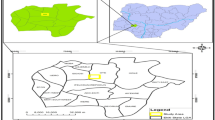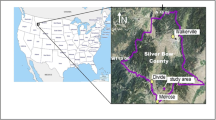Abstract
The integrated interpretation of data from various technologies has the potential to obtain a more accurate estimate of subterranean earth properties. In this paper, we implement the joint interpretation of geological and geophysical data for mineral exploration in the northeastern region of Inner Mongolia, China. The joint application of several methodologies reduces the exploration risk. We first determined an approximate and large potential area for mineral exploration with geological data and magnetic data interpretation in Gaoerqi. Results from the two types of data analysis show that the ore deposit strikes roughly east in the northern part of the Gaoerqi mining area. Next, we employed the audio-magnetotelluric (AMT) method to study the subterranean electrical resistivity distribution and divide the earth into four layers. Inverted resistivity sections from the AMT data illustrate that the ore deposits are likely developed in the low-resistivity zone of the survey area from the land surface to 300-m depth. Finally, the high-resolution borehole-to-surface electrical resistivity tomography (ERT) method was employed for further investigation of the location and attitude of the potential ore deposits. Inverted resistivity sections from the ERT data show that two prospective areas for mineral exploration were observed in the west of the survey area and that the eastern portion of the survey area warrants further investigation.







Similar content being viewed by others
References
Al-Garni, M. A. (2009). Interpretation of some magnetic bodies using neural networks inversion. Arabian Journal of Geosciences, 2, 175–184.
Belyavskii, V. V., & Sukhoi, V. V. (2004). The method of audio-frequency magnetotelluric sounding in mineral exploration. Izvestiya-Physics of the Solid Earth, 40, 515–533.
Cordell, L., (1979). Gravimetric expression of graben faulting in Santa Fe country and the Espanola basin, New Mexico. In: Ingersoll, R. V., Woodward, L. A., James, H. L. (eds.) New Mexico Geological Society 30th Annual Fall Field Conference Guidebook, pp. 59–64.
Daniels, J. J., & Dyck, A. V. (1984). Borehole resistivity and electromagnetic methods applied to Mineral exploration. IEEE Transactions on Geoscience and Remote Sensing, 22, 80–87.
Garman, K. M. & Purcell, S. F. (2004). Geologic evaluations beneath existing structures using foundation imager™ three dimensional resistivity surveys. In Symposium on the Application of Geophysics to Engineering and Environmental Problems 2004, pp. 1107–1113.
Hansen, R. O., Racic, L. & Grauch, V. (2005). Magnetic methods in near-surface geophysics. In Near-surface geophysics (pp. 151–176). Society of Exploration Geophysicists.
Hood, P. J., & Teskey, D. J. (1989). Aeromagnetic gradiometer program of the Geological Survey of Canada. Geophysics, 54, 1012–1022.
Li, Y. G., & Oldenburg, D. W. (1994). Inversion of 3-D Dc resistivity data using an approximate inverse mapping. Geophysical Journal International, 116, 527–537.
Mackie, R. L., & Madden, T. R. (1993). Three-dimensional magnetotelluric inversion using conjugate gradients. Geophysical Journal International, 115, 215–229.
Meijerink, J. A., & van der Vorst, H. A. (1977). An iterative solution method for linear systems of which the coefficient matrix is a symmetric. Mathematics of computation, 31, 148–162.
Meying, A., Mbarga, T. N., Gouet, D., & Stéphane, P. A. (2013). Near surface fractures evidence from Audio-Magnetotelluric (AMT) investigation in Ayos-Nguelemendouka area (Eastern Cameroon). International Journal of Geosciences, 04, 480–493.
Miller, H. G., & Singh, V. (1994). Potential field tilt—a new concept for location of potential field sources. Journal of Applied Geophysics, 32, 213–217.
Nogueira, P. V., Rocha, M. P., Borges, W. R., Silva, A. M., & de Assis, L. M. (2016). Study of iron deposit using seismic refraction and resistivity in Carajas Mineral Province, Brazil. Journal of Applied Geophysics, 133, 116–122.
Oldenburg, D. W., & Li, Y. (2005). Inversion for applied geophysics: A tutorial (pp. 89–150). Near-surface Geophysics: SEG.
Perrone, A., Lapenna, V., & Piscitelli S. (2014). Electrical resistivity tomography technique for landslide investigation.: A review. Earth-Science Reviews, 135(2014), 65–82
Poole, E. L., & Ortega, J. M. (1987). Multicolor ICCG Methods for Vector Computers. SIAM Journal on Numerical Analysis, 24, 1394–1418.
Spitzer, K. (1995). A 3-D finite-difference algorithm for Dc resistivity modeling using conjugate-gradient methods. Geophysical Journal International, 123, 903–914.
Strangway, D. W., Swift, C. M., Jr., & Holmer, R. C. (1973). The application of audio-frequency magnetotellurics (AMT) to mineral exploration. Geophysics, 38, 1159–1175.
Sultan, S. A., Mansour, S. A., Santos, F. M., & Helaly, A. S. (2009). Geophysical exploration for gold and associated minerals, case study: Wadi El Beida area, South Eastern Desert, Egypt. Journal of Geophysics and Engineering, 6, 345–356.
Wang, T. L., & Mezzatesta, A. (2001). 3-D dc resistivity modeling using the sweeping-seed, conjugate-gradient method. Geophysics, 66, 441–447.
Wang, W., Pan, Y., & Qiu, Z. (2009). A new edge recognition technology based on the normalized vertical derivative of the total horizontal derivative for potential field data. Applied Geophysics, 5, 471–482.
Wang, G. W., Zhang, S. T., Yan, C. H., Xu, G. Y., Ma, M., Li, K., et al. (2012). Application of the multifractal singular value decomposition for delineating geophysical anomalies associated with molybdenum occurrences in the Luanchuan ore field (China). Journal of Applied Geophysics, 86, 109–119.
Wang, W. L., Zhao, J., & Cheng, Q. M. (2013). Application of singularity index mapping technique to gravity/magnetic data analysis in southeastern Yunnan mineral district, China. Journal of Applied Geophysics, 92, 39–49.
Yamaguchi, S., Ogawa, Y., Fuji-ta, K., Ujihara, N., Inokuchi, H., & Oshiman, N. (2010). Audio-frequency magnetotelluric imaging of the Hijima fault, Yamasaki fault system, southwest Japan. Earth Planets Space, 62, 401–411.
Zhou, D., Wang, W., Wang, J., Pang, X., Cai, D., & Sun, Z. (2006). Mesozoic subduction-accretion zone in northeastern South China Sea inferred from geophysical interpretations. Science in China, Series D: Earth Sciences, 49, 471–482.
Acknowledgements
This work was co-supported by the Major Program of the National Natural Science Foundation of China under Grant No. 41630320, China Geology Survey under Grant No. 12120113098800 and Grant No. 1212011120204, and National High Technology Research and Development Program of China (863 Program) under Grant No. 2014AA06A610 and China Postdoctoral Science Foundation Funded Project. GZ is grateful for research support from the School of Geophysics and Information Technology, China University of Geosciences (Beijing), and Geological Survey Institute of Inner Mongolia. Moreover, GZ thanks to all the members of the research group for their hard work of collecting the magnetic, AMT and ERT data. We especially wish to mention the assistance of Dr. Ling-Jun Guo provided the geological data. The hard work of all members of the research group and the research support of the university and institutes have contributed to the achievement of this paper. The authors would like to thank the reviewers and editors for giving the constructive suggestions. GZ would also like to thank the Elsevier language editing service for polishing the paper.
Author information
Authors and Affiliations
Corresponding authors
Electronic supplementary material
Below is the link to the electronic supplementary material.
Rights and permissions
About this article
Cite this article
Zhang, G., Lü, QT., Zhang, GB. et al. Joint Interpretation of Geological, Magnetic, AMT, and ERT Data for Mineral Exploration in the Northeast of Inner Mongolia, China. Pure Appl. Geophys. 175, 989–1002 (2018). https://doi.org/10.1007/s00024-017-1733-5
Received:
Revised:
Accepted:
Published:
Issue Date:
DOI: https://doi.org/10.1007/s00024-017-1733-5




